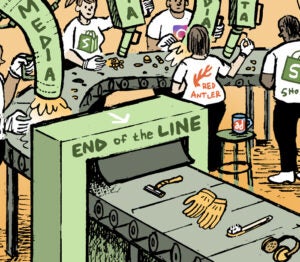Many of the shopping behaviors that developed over the past couple of years due to COVID-19 have solidified and appear here to stay.
The majority of consumers (56%) say they plan to shop primarily or exclusively online this holiday season, and more than three-quarters say they’ll use in-store pickup services this year as much or more than last year, according to recent research from performance marketing agency Tinuiti.
But many shoppers aren’t just going to show up without confirming that what they want is in stock.
Forrester found that nearly one-third of US online holiday shoppers will check online first to see whether an item is available before heading to a physical store.
That means retailers should expect and prepare themselves for a sizable wave of in-store shoppers, an uptick in curbside pickup and a high volume of requests coming in from online shoppers looking to secure limited stock items, said Phil Melson, a retail client partner at data analytics provider Fractal Analytics.
“The mental math done by individual shoppers choosing to rush to a store to buy something off the shelf versus securing online and picking up later will be case by case and interesting to see,” he said.
But retailers have their own mental math to do.
The average Black Friday discount offer this year will be lower than Black Fridays of yore, according to data from market intelligence platform StyleSage.
“Many retail stores won’t be able to restock on the merchandise once they sell out of an item they have and will risk staying out of stock on those items for much longer than usual,” said Wiley Zhang, COO of Acquco, a newly launched startup that acquires and scales third-party sellers on Amazon.
Supply-chain bottlenecks are largely to blame for this dynamic, he said. A lack of supply combined with high consumer demand is leading to product and labor shortages, and the overall increase in the price of raw materials is leading retailers to offset higher costs by reducing promotions and selling certain products at full price, Zhang said.
But some retailers responded by debuting their Black Friday deals last month to mollify “nervous online shoppers” who have been making their holiday purchases earlier this year, said Bryan Cano, director of media strategy at online retail advertising startup StitcherAds, which was acquired by Kargo in October.
AdExchanger Daily
Get our editors’ roundup delivered to your inbox every weekday.
Daily Roundup
“Digital is more critical than ever during a period like this because it’s a more adaptive channel than brick and mortar,” said Cano, who predicts a marked increase in the number of holiday sales offered on the web this year.
But of more importance to many online shoppers this season is the cost of shipping rather than the price of a product, according to a survey conducted by CommerceNext, which also found that around a third of merchants are cutting back on promotions and offers during Thanksgiving, Cyber Monday and throughout the month of December, presumably due to the shortage of inventory to promote, said Sucharita Kodali, a VP and principal analyst at Forrester.
And so “Cyber 5,” the five-day stretch from Thanksgiving through Cyber Monday, might be softer this year, said Josh Brisco, VP of growth media at Tinuiti.
But marketers have been rolling with the punches, and they’ve “done well in attempting to navigate the macroeconomic challenges presented this year,” he said.
“Whether that be forcing the narrative of the earlier promotional cycle to retailers or crafting creative ways to maximize marketing efforts based on existing and forecasted inventories of goods,” Brisco said, “the marketer is an ever-important factor in a retailer’s ability to find success in a holiday season with so many brand-new challenges.”
And the balancing act will continue as retailers do the best they can to account for supply-chain snarls and marketers manage reduced promotional volume without sacrificing too much overall sales.
“I don’t know that there is much else they can do,” Kodali said. “These marketers are definitely making lemonade with lemons.”














